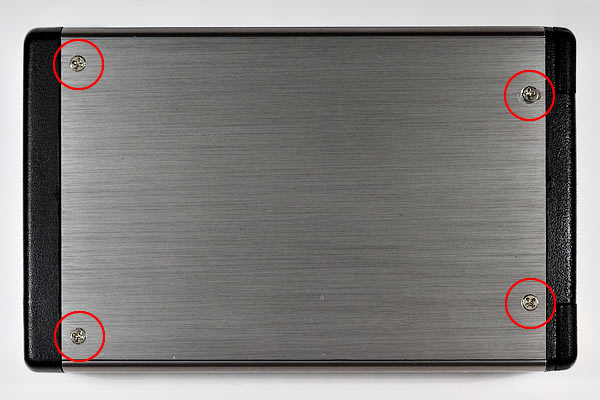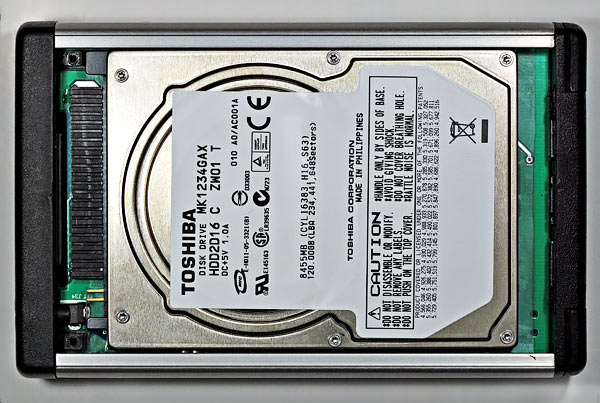| 1: Intro & spec | 2: First impressions | 3: Installing an HDD | 4: User interface | 5: Timings & performance | 6: Compared to | 7: Conclusion |
CompactDrive PD70X portable storage device review
3: Installing a hard disk
If you've bought your PD70X as a bare unit, i.e. one without a HDD fitted, the first thing you need to do is physically install your hard disk.
Installation is easy; just lift off the back of the case, remove the black clip, and slide the drive in. The good news is that on the review sample there are no sharp edges to cut yourself on.
How to install the disk
Note: Whilst many people successfully install hard disks without any form of anti-static precautions, there's always a possibility that you'll be unlucky. Always use proper anti static procedures where possible. Ideally that means you'll work on an anti-static mat, and be wearing an anti-static wrist stap - both earthed.
The first step is to remove any batteries you may have installed.
Next, remove the back of the PD70X. Mine was supplied bare, and the back of the case was not screwed together, so it simply lifted off. The easy way to check is to look at the underside of the device, if there are four empty holes then the cover should just lift off. If not, you'll have to unscrew the back cover.
Note how one set of screws is closer together than the other; you'll need to remember which way round the panel goes when you're reassembling. Fortunately it's easy enough to remove and rotate the backplate if you do make a mistake.
Once open, this is what we should find. Notice the large black block on the left? That's the PATA connector, which we'll be attaching the hard disk to.
The next step is to remove the black clip from the right hand side. Gently squeeze the ends of the clip, and pull it out.
Now we insert the hard disk. Remove it from its anti-static protective packaging, and handle by the sides if possible. Do not apply pressure to the top of the drive, and be careful of the pins, as they're easily bent.
Check the pins on the drive; they should all be straight. If they're not, DO NOT ATTEMPT to install the hard disk. Bent pins could permanently damage both the PD70X and the hard disk itself.
Move the hard disk into position, and check the alignment of the pins against the connector. See the area where there are no pins on the drive, and correspondingly no holes in the block? That tells you which way up the disk needs to go. In most cases, it's label upwards, obviously with the pins facing the connector.
Now gently slide the hard disk towards the connector, being careful to align the pins on the drive with those on the connector, and to avoid pressing on the top of the hard disk.
Here's how the drive should look when you're done; notice how the pins on the hard disk are completely inside the connector on the PD70X:
Next, push in the plastic clip on the right hand side. The clip is to prevent the HD from sliding loose, and also provides an anchoring point for two of the screws.
Finally, carefully place the back cover back on the PD70X - it should go on easily. Find the four screws, which should be in a small bag inside the box somewhere, and tighten them gently but firmly until they don't rotate easily.
Now that you've installed the hard disk, you're ready to format the drive! Make sure you have a freshly charged set of batteries at this point.
Insert the batteries, and if the drive is unformatted the PD70X will show an Error 18 message; to format you'll need to rotate the wheel clockwise, then anti-clockwise, and finally push it in.
3: Installing a hard disk
If you've bought your PD70X as a bare unit, i.e. one without a HDD fitted, the first thing you need to do is physically install your hard disk.
Installation is easy; just lift off the back of the case, remove the black clip, and slide the drive in. The good news is that on the review sample there are no sharp edges to cut yourself on.
How to install the disk
Note: Whilst many people successfully install hard disks without any form of anti-static precautions, there's always a possibility that you'll be unlucky. Always use proper anti static procedures where possible. Ideally that means you'll work on an anti-static mat, and be wearing an anti-static wrist stap - both earthed.
The first step is to remove any batteries you may have installed.
Next, remove the back of the PD70X. Mine was supplied bare, and the back of the case was not screwed together, so it simply lifted off. The easy way to check is to look at the underside of the device, if there are four empty holes then the cover should just lift off. If not, you'll have to unscrew the back cover.

Note how one set of screws is closer together than the other; you'll need to remember which way round the panel goes when you're reassembling. Fortunately it's easy enough to remove and rotate the backplate if you do make a mistake.
Once open, this is what we should find. Notice the large black block on the left? That's the PATA connector, which we'll be attaching the hard disk to.

The next step is to remove the black clip from the right hand side. Gently squeeze the ends of the clip, and pull it out.
Now we insert the hard disk. Remove it from its anti-static protective packaging, and handle by the sides if possible. Do not apply pressure to the top of the drive, and be careful of the pins, as they're easily bent.
Check the pins on the drive; they should all be straight. If they're not, DO NOT ATTEMPT to install the hard disk. Bent pins could permanently damage both the PD70X and the hard disk itself.
Move the hard disk into position, and check the alignment of the pins against the connector. See the area where there are no pins on the drive, and correspondingly no holes in the block? That tells you which way up the disk needs to go. In most cases, it's label upwards, obviously with the pins facing the connector.

Now gently slide the hard disk towards the connector, being careful to align the pins on the drive with those on the connector, and to avoid pressing on the top of the hard disk.
Here's how the drive should look when you're done; notice how the pins on the hard disk are completely inside the connector on the PD70X:

Next, push in the plastic clip on the right hand side. The clip is to prevent the HD from sliding loose, and also provides an anchoring point for two of the screws.
Finally, carefully place the back cover back on the PD70X - it should go on easily. Find the four screws, which should be in a small bag inside the box somewhere, and tighten them gently but firmly until they don't rotate easily.
Now that you've installed the hard disk, you're ready to format the drive! Make sure you have a freshly charged set of batteries at this point.
Insert the batteries, and if the drive is unformatted the PD70X will show an Error 18 message; to format you'll need to rotate the wheel clockwise, then anti-clockwise, and finally push it in.

